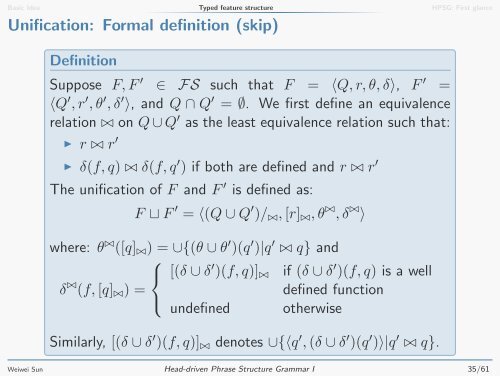Head-driven Phrase Structure Grammar I
Head-driven Phrase Structure Grammar I Head-driven Phrase Structure Grammar I
Basic Idea Typed feature structure HPSG: First glance Unification: Formal definition (skip) Definition Suppose F, F ′ ∈ FS such that F = 〈Q, r, θ, δ〉, F ′ = 〈Q ′ , r ′ , θ ′ , δ ′ 〉, and Q ∩ Q ′ = ∅. We first define an equivalence relation ⊲⊳ on Q ∪ Q ′ as the least equivalence relation such that: ◮ r ⊲⊳ r ′ ◮ δ(f, q) ⊲⊳ δ(f, q ′ ) if both are defined and r ⊲⊳ r ′ The unification of F and F ′ is defined as: F ⊔ F ′ = 〈(Q ∪ Q ′ )/ ⊲⊳ , [r] ⊲⊳ , θ ⊲⊳ , δ ⊲⊳ 〉 where: θ ⊲⊳ ([q] ⊲⊳ ) = ∪{(θ ∪ θ ′ )(q ′ )|q ′ ⊲⊳ q} and ⎧ ⎨ [(δ ∪ δ ′ )(f, q)] ⊲⊳ if (δ ∪ δ ′ )(f, q) is a well δ ⊲⊳ (f, [q] ⊲⊳ ) = defined function ⎩ undefined otherwise Similarly, [(δ ∪ δ ′ )(f, q)] ⊲⊳ denotes ∪{〈q ′ , (δ ∪ δ ′ )(q ′ )〉|q ′ ⊲⊳ q}. Weiwei Sun Head-driven Phrase Structure Grammar I 35/61
Basic Idea Typed feature structure HPSG: First glance Unification: An example (1) q 1 AGR q 2 P ERS q 3 q 0 SUBJ q 6 P RED P ERS q 4 AGR q 5 NUM q 7 ◮ Q = {q 0 , q 1 , q 2 , q 3 , q 4 , q 5 , q 6 , q 7 } ◮ r = q 0 ◮ θ = {q 0 → predicate, q 1 → noun, q 2 → agreement, q 3 → 3rd, q 4 → verb, q 5 → agreement, q 6 → 3rd, q 7 → singular} ◮ δ = {(SUBJ, q 0 ) → q 1 , (P RED, q 0 ) → q 4 , (AGR, q 1 ) → q 2 , (P ERS, q 2 ) → q 3 , (AGR, q 4 ) → q 5 , (P ERS, q 5 ) → q 6 , (NUM, q 5 ) → q 7 } Weiwei Sun Head-driven Phrase Structure Grammar I 36/61
- Page 1 and 2: Head-driven Phrase Structure Gramma
- Page 3 and 4: Basic Idea Typed feature structure
- Page 5 and 6: Basic Idea Typed feature structure
- Page 7 and 8: Basic Idea Typed feature structure
- Page 9 and 10: Basic Idea Typed feature structure
- Page 11 and 12: Basic Idea Typed feature structure
- Page 13 and 14: Basic Idea Typed feature structure
- Page 15 and 16: Basic Idea Typed feature structure
- Page 17 and 18: Basic Idea Typed feature structure
- Page 19 and 20: Basic Idea Typed feature structure
- Page 21 and 22: Basic Idea Typed feature structure
- Page 23 and 24: Basic Idea Typed feature structure
- Page 25 and 26: Basic Idea Typed feature structure
- Page 27 and 28: Basic Idea Typed feature structure
- Page 29 and 30: Basic Idea Typed feature structure
- Page 31 and 32: Basic Idea Typed feature structure
- Page 33 and 34: Basic Idea Typed feature structure
- Page 35 and 36: Basic Idea Typed feature structure
- Page 37: Basic Idea Typed feature structure
- Page 41 and 42: Basic Idea Typed feature structure
- Page 43 and 44: Basic Idea Typed feature structure
- Page 45 and 46: Basic Idea Typed feature structure
- Page 47 and 48: Basic Idea Typed feature structure
- Page 49 and 50: Basic Idea Typed feature structure
- Page 51 and 52: Basic Idea Typed feature structure
- Page 53 and 54: Basic Idea Typed feature structure
- Page 55 and 56: Basic Idea Typed feature structure
- Page 57 and 58: Basic Idea Typed feature structure
- Page 59 and 60: Basic Idea Typed feature structure
- Page 61 and 62: Basic Idea Typed feature structure
- Page 63 and 64: Basic Idea Typed feature structure
- Page 65 and 66: Basic Idea Typed feature structure
- Page 67 and 68: Basic Idea Typed feature structure
- Page 69 and 70: Basic Idea Typed feature structure
- Page 71 and 72: Basic Idea Typed feature structure
- Page 73: Basic Idea Typed feature structure
Basic Idea Typed feature structure HPSG: First glance<br />
Unification: Formal definition (skip)<br />
Definition<br />
Suppose F, F ′ ∈ FS such that F = 〈Q, r, θ, δ〉, F ′ =<br />
〈Q ′ , r ′ , θ ′ , δ ′ 〉, and Q ∩ Q ′ = ∅. We first define an equivalence<br />
relation ⊲⊳ on Q ∪ Q ′ as the least equivalence relation such that:<br />
◮ r ⊲⊳ r ′<br />
◮ δ(f, q) ⊲⊳ δ(f, q ′ ) if both are defined and r ⊲⊳ r ′<br />
The unification of F and F ′ is defined as:<br />
F ⊔ F ′ = 〈(Q ∪ Q ′ )/ ⊲⊳ , [r] ⊲⊳ , θ ⊲⊳ , δ ⊲⊳ 〉<br />
where: θ ⊲⊳ ([q] ⊲⊳ ) = ∪{(θ ∪ θ ′ )(q ′ )|q ′ ⊲⊳ q} and<br />
⎧<br />
⎨ [(δ ∪ δ ′ )(f, q)] ⊲⊳ if (δ ∪ δ ′ )(f, q) is a well<br />
δ ⊲⊳ (f, [q] ⊲⊳ ) =<br />
defined function<br />
⎩<br />
undefined otherwise<br />
Similarly, [(δ ∪ δ ′ )(f, q)] ⊲⊳ denotes ∪{〈q ′ , (δ ∪ δ ′ )(q ′ )〉|q ′ ⊲⊳ q}.<br />
Weiwei Sun <strong>Head</strong>-<strong>driven</strong> <strong>Phrase</strong> <strong>Structure</strong> <strong>Grammar</strong> I 35/61



